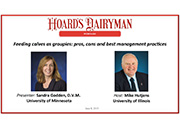 The basic concepts of raising calves applies to both individually and group-raised animals. The importance of proper nutrition; dry and comfortable bedding; and well-ventilated areas are universal. Sandra Godden, D.V.M., University of Minnesota, shared these messages during the June webinar, while providing insight into group feeding of preweaned calves.
The basic concepts of raising calves applies to both individually and group-raised animals. The importance of proper nutrition; dry and comfortable bedding; and well-ventilated areas are universal. Sandra Godden, D.V.M., University of Minnesota, shared these messages during the June webinar, while providing insight into group feeding of preweaned calves.Calves should double their birth weight by weaning, which is typically 8 weeks. Historically, feeding 10 percent of birth weight was common, but won't yield today's desired weaning weights. Today, 20 percent is suggested and accelerated feeding (crude protein bumped to 28 percent) is becoming more accepted. "Don't push it higher. Try to mimic what the cow would produce, which is 26 percent crude protein and 29 percent fat," shared Godden.
Milk's nutrients are needed for growth, dealing with cold stress, and helping maintain a healthy immune system. Benefits of additional milk consumption are also long-term. Those heifers will calve earlier and produce more in their first lactation and, probably, more in later lactations.
Raising calves in individual pens minimizes calf-to-calf contact, but that's not possible with group housing. Accordingly, group-housed facilities should operate on an all-in and all-out strategy. This prevents a disease from lingering in a pen and being passed on to every new addition.
Group-housed animals express different social behavior. This may mean they are better at competing for feed and space.
In automated feeding systems, it is important that calves don't have to wait when they want a meal and that they have plenty of time to drink without being harassed by other calves.
Suppliers of the automated feeding systems often say that each station can handle 25 to 30 calves. However, both research and on-farm experience confirms that we should avoid group sizes larger than eight to 10 calves. Calves raised in groups larger than this do not gain weight as well and are more susceptible to respiratory disease and other health problems.
Regardless of the housing system you use, buckets, nipples and tubing should be cleaned regularly and discarded when worn. Bacteria can multiply and impact milk quality, and, ultimately, calf health when sanitation becomes lax. Studies have shown that automated feeding systems do not always clean and sanitize themselves well. You should take coliform and standard plate count (SPC) tests to ensure that sanitation procedures are done properly.
Calves need a consistent milk meal. Milk dispensed in pens should remain at a constant temperature – about body temperature. Also, whole milk is generally 13.5 percent solids. What the calf drinks should mirror its dam's milk. When neglected, these circumstances result in swings in consumption, as well as cause digestive issues.
"Just because it's an automated system, doesn't mean you can forget about your calves," reminded Godden. "You still need to monitor for illness."
Learn more about calves, watch the June webinar. It's archived and available for viewing. Past webinars can be found at www.hoards.com/webinars.

The author is the online media manager and is responsible for the website, webinars and social media. A graduate of Modesto Junior College and Fresno State, she was raised on a California dairy and frequently blogs on youth programs and consumer issues.









